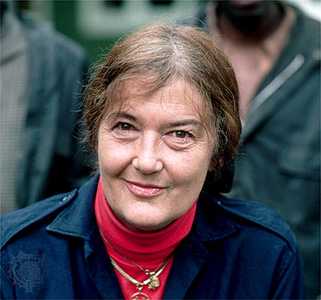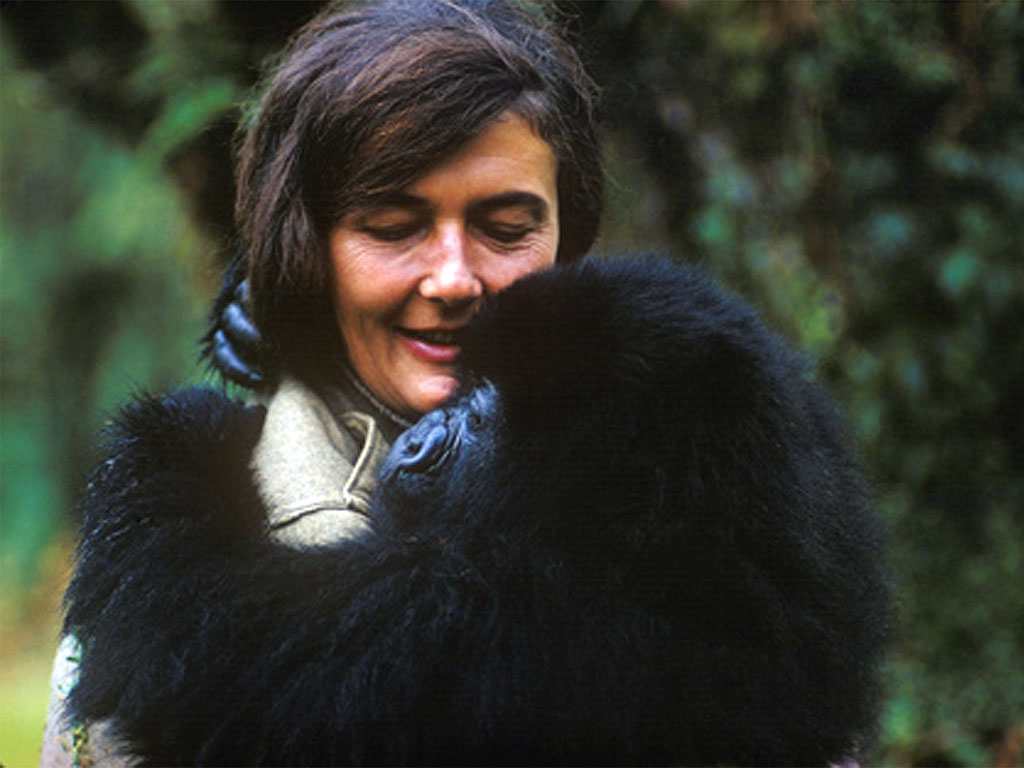In the 1960s, famed paleontologist Louis Leakey challenged the historically male face of primatology by sponsoring the field research of Dian Fossey, Jane Goodall and Birute Galdikas – three women who would become affectionately known as the “trimates.”
Fossey’s observations of the reclusive mountain gorilla in Rwanda were detailed in her popular book Gorillas in the Mist and she worked tirelessly throughout her career to personalize this poorly known animal for people around the world. Through visual references and careful description of behavior, Fossey replaced a fallacious stereotype of a King Kong-like, violent gorilla with an almost idealized image of a gorilla that was intelligent, family-oriented and peaceful.
 |
Thirty years ago this month Fossey was murdered in her field station while she slept. The lack of theft and the brutal nature of the murder, reportedly inflicted by machete, suggested a range of possible suspects including disgruntled employees, vengeful poachers and angry locals. Her murder remains unsolved.
She and her work were not uncontroversial. Throughout my undergraduate and graduate training in Anthropology, if Fossey was mentioned at all it was only briefly, and the professor quickly moved on to the less controversial Jane Goodall. Much as one might discuss a relative with an unsavory past, Fossey’s reputation and fame always seemed tainted by something inappropriate.
Shortly after her murder, Montgomery Brower wrote of Fossey in People magazine (February 17, 1986): “Fossey, it appears, was no saint. Though she had boundless patience and affection for the gorillas, she was by temperament and conviction often at odds with people.”
Two different stories about Fossey have emerged: One describes her as a loner who was disgusted with humanity and who belittled her fellow workers, orchestrated violent tortures of poachers, performed witchcraft on political enemies and even kidnapped the children of those that threatened “her” gorillas.
The other portrays Fossey as an everyday person inspired to fight for animal rights and willing to put her life on the line to confront powerful government officials, local tribal leadership and poachers.
This latter image is reinforced by Sigourney Weaver’s portrayal of Fossey in the 1988 film also titled Gorillas in the Mist. Hal Hinson of the Washington Post (September 23, 1988) noted of the film upon its release that Weaver’s Fossey created something of a caricature of the woman driven by “misdirected maternal impulses” and by a “love for her animal babies.”
 |
Much of Fossey’s legacy lies in her controversial approach to conservation. Fossey was an ardent proponent of “active conservation” which promoted aggressive, in-person defense of threatened species rather than the creation of new local laws or the development of long-term conservation strategies.
Her conservation philosophy suggests an inherent conflict between native human communities living near primates and conservationists who often come from wealthy, developed countries. Fossey lived this philosophy while confronting government officials, cutting poacher’s nets, poisoning hunting dogs and encouraging her gorillas’ fear of black Africans whom she reasoned were the most likely to be poachers.
This conflict mentality has rightly been pushed to the periphery of mainstream conservation as it places the conservationist in a paternalistic role, likely to be viewed as oppressive by local communities.
 |
Boabeng-Fiema Monkey Sanctuary, Ghana: Site of the author's research and a growing ecotourism enterprise featuring locally guided tours and close-up observation of two wild primate species: Lowe's Guenon and the Ursine Colobus (photo by author). |
Nearly continuous research spearheaded through the University of Calgary at my former field site in Ghana, West Africa, for example, has demonstrated that working with, rather than against, local communities is a more productive approach to conservation.
At this site, a coalition between the local community, national wildlife representatives and international researchers (stakeholders with sometimes contrasting goals) has helped to build a growing ecotourism venture that works to strengthen already existing local affinities with the primates.
Much like Goodall, Fossey has also been criticized for anthropomorphizing her study subjects. From creating gorilla cemeteries to the well-documented maternal role she took on for a young male gorilla named “Digit,” it is clear that Fossey developed strong emotional connections to her research subjects. This violation of scientific objectivity has rightfully forced researchers to question how we should describe the animals we study and how emotionally invested we should become in their lives.
However, when Walter Kronkite announced the murder of Digit by poachers on the CBS Evening News, it was our ability to empathize with the gorilla—a product of Fossey’s work popularizing his life—that led to an international outpouring of grief, the creation of the Digit Fund to protect gorillas, and a heightened awareness of the mountain gorilla’s conservation status.
Had we not gotten to know Digit as an individual personality, even if it was artificially constructed, would we have cared about his or any gorilla’s loss? One cannot help but see parallels with the world’s reaction to the recent killing of Cecil the lion in Zimbabwe by a Minnesota dentist.
It is through the personal connections we develop with these animals that our impact on their lives, habitat, and communities becomes clear.
 |
There is no doubt that Dian Fossey will remain a controversial figure in the history of conservation. She forced us all to ask questions about our place in nature and motivated the scientific community to examine how and why we describe animals the way that we do.
As American society debates issues such as exotic animals as pets, the role of animals in zoos, entertainment and medical research, and our personal role as international consumers and tourists, Fossey, like many other conservationists before and since, challenged us to look at these animals as intelligent and self-aware beings.
Our ability to see ourselves in the Digits and Cecils of the world may be Fossey’s greatest contribution of all.
